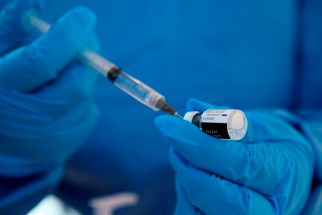New wrinkle in ever-evolving vaccine rollout plan
Read this article for free:
or
Already have an account? Log in here »
To continue reading, please subscribe:
Monthly Digital Subscription
$0 for the first 4 weeks*
- Enjoy unlimited reading on winnipegfreepress.com
- Read the E-Edition, our digital replica newspaper
- Access News Break, our award-winning app
- Play interactive puzzles
*No charge for 4 weeks then price increases to the regular rate of $19.00 plus GST every four weeks. Offer available to new and qualified returning subscribers only. Cancel any time.
Monthly Digital Subscription
$4.75/week*
- Enjoy unlimited reading on winnipegfreepress.com
- Read the E-Edition, our digital replica newspaper
- Access News Break, our award-winning app
- Play interactive puzzles
*Billed as $19 plus GST every four weeks. Cancel any time.
To continue reading, please subscribe:
Add Free Press access to your Brandon Sun subscription for only an additional
$1 for the first 4 weeks*
*Your next subscription payment will increase by $1.00 and you will be charged $16.99 plus GST for four weeks. After four weeks, your payment will increase to $23.99 plus GST every four weeks.
Read unlimited articles for free today:
or
Already have an account? Log in here »
Hey there, time traveller!
This article was published 28/12/2020 (1808 days ago), so information in it may no longer be current.
It seems nothing is straightforward in the roll-out of the COVID-19 vaccine.
Shipping logistics are complicated (the two vaccines now approved in Canada must be delivered and stored in deep-freeze temperatures: Pfizer-BioNTech at -70 C, Moderna at -20 C); decisions around who gets immunized first are controversial; and the creation of “super clinics” for mass immunization is expected to be one of the greatest challenges provincial health systems have ever faced.
Even the amount delivered in early shipments was a surprise — but a happy one. There was enough of the precious liquid in each vial for six doses of the Pfizer vaccine (instead of the five stated by the manufacturer), allowing for more immunizations than expected.
The newest wrinkle in deployment planning, or at least a new consideration that could be life or death: do provinces continue to hold back half their vaccine allotments for follow-up shots, or should they immunize as many people now and use future shipments for the second dose?
The former was the original recommendation, but new research and information is emerging challenging that approach.
The argument in favour of holding back doses is it provides protection against potential supply chain breakdowns.
A second shot of the COVID-19 vaccine is required for both the Pfizer and Moderna versions (21-28 days after the first) to bring efficacy levels above 90 per cent. Holding back half the allotment guarantees enough supply for the booster.
However, as manufacturers demonstrate their ability to meet delivery dates, the perceived risk of supply chain breakdowns is diminishing. There’s now greater confidence subsequent shipments will be on time.
Data released earlier this month from Pfizer and Moderna’s clinical trials show relatively strong protection after the first dose: about 50 per cent for both vaccines (rising to 92 per cent in some for the Moderna version, even before the second jab).
A study out of the University of Toronto unveiled last week found holding back fewer doses and immunizing more people quicker could reduce COVID-19 infections by as much as 42 per cent.
British Columbia is already bucking the trend: its provincial health officer, Dr. Bonnie Henry, said two weeks ago B.C. had no plans to hold back doses.

“Making sure that we protect as many people as possible with that first dose is our first priority, recognizing that we are receiving more vaccine in higher quantities in the weeks to come,” said Henry. “I have a real challenge leaving vaccines in the fridge when there’s so many people at risk right now.”
The just-in-time supply strategy is not without risk. No one really knows how long protection lasts from the first shot; it could wear off in a few weeks. That’s why the follow-up booster is critical and should be administered within the required timeline, experts say.
A delay in subsequent shipments could jeopardize that.
However, it’s also unclear whether delaying the second shot by a week or two would have a material impact on efficacy.
Even Canada’s National Advisory Committee on Immunization, which released an “ethical analysis” last week on whether to hold back doses, didn’t come to a definitive conclusion. NACI said there are risks and benefits to both approaches.
“Provinces and territories will have to determine the best course of action based on their own analysis and logistical contexts, including risks and unintended consequences that may occur as a result of delaying the second dose of vaccine,” NACI wrote.
What it comes down to is how confident provinces are in the timing of future shipments.
It would make little sense to hold back doses (especially when COVID-19 case counts are expected to soar after the holidays) if there were a high degree of certainty in delivery timelines.
Most provinces, including Manitoba, have shown no signs they plan to switch strategies on how to administer the vaccine, but that could change as more evidence and analysis emerges.
tom.brodbeck@freepress.mb.ca

Tom has been covering Manitoba politics since the early 1990s and joined the Winnipeg Free Press news team in 2019.
Our newsroom depends on a growing audience of readers to power our journalism. If you are not a paid reader, please consider becoming a subscriber.
Our newsroom depends on its audience of readers to power our journalism. Thank you for your support.






